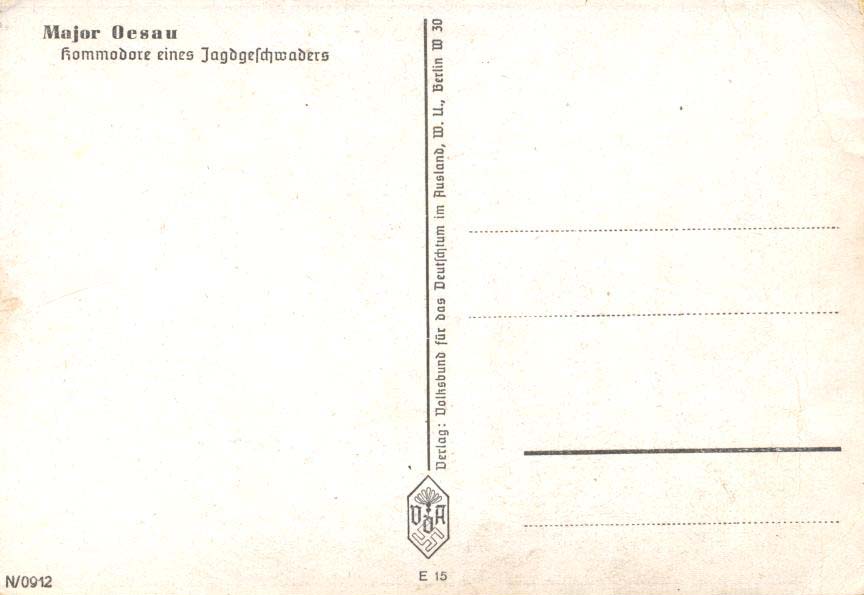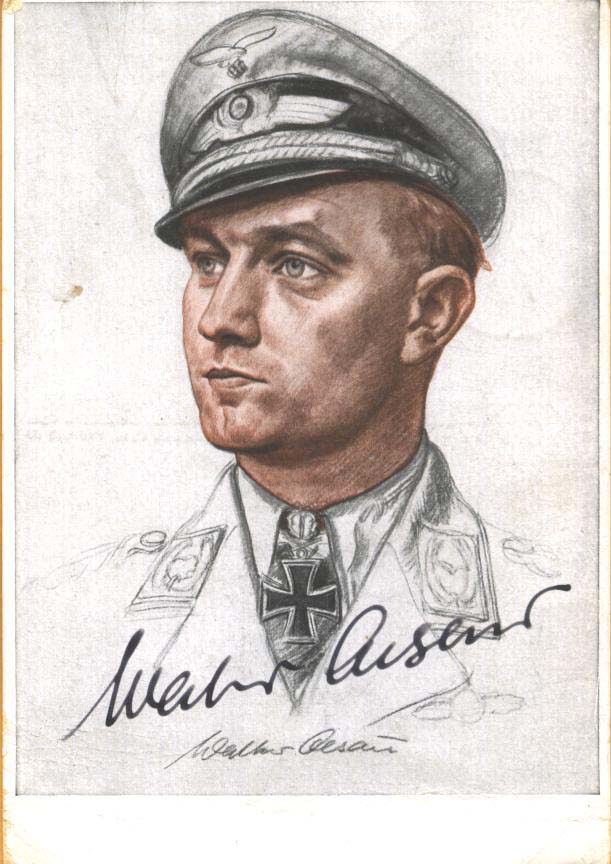

|
OESAU Walter
Oberst
Oesau, Walter
* 28.06.1913 Farnewinkel, Krs. Dithmarschen
+ 11.05.1944 bei St. Vith
Awarded Knights Cross: 20.08.1940
as: Hauptmann Staffelkapitän 7./JG 51
Awarded Oakleaves as the 9th Recipient: 06.02.1941 as Hauptmann
Kommandeur III./JG 3
Awarded Swords as the 3rd Recipient : 15.07.1941 as Hauptmann
Kommandeur III./JG 3
Walter "Gulle" Oesau
BORN: 28 June 1913
KILLED IN ACTION: 11 May 1944
VICTORIES: 127 over 300 missions. (INCLUDING 27 Spitfires, 14 four-engined bommbers, and 9 in the Spanish Civil War.)
Awards
• Spanish Medalla de la Campaña
• Spanish Medalla Militar
• Spanish Cross in Gold with Swords and Diamonds
• Iron Cross (1939) 2nd and 1st Class
• Front Flying Clasp of the Luftwaffe in Gold for fighter pilots with pennant "300"
• Wound Badge (1939) in Black
• German Cross in Gold on 17 October 1943
• Knight's Cross of the Iron Cross with Oak Leaves and Sword
o Knight's Cross on 20 August 1940
o 9th Oak Leaves on 6 February 1941
o 3rd Swords on 15 July 1941
He served with the Condor Legion during the Spanish Civil War, with 3 Staffel of JG 88 claiming 8 aircraft during the campaign, becoming one of only 28 people to earn the award of the Spanish Cross in Gold and Diamonds.
At the start of World War II, Oesau was given command of 2 Staffel JG 20. The group was moved to the Eastern front at the start of the Invasion of Poland, moving back to the Western Front later as the redesignated III Gruppe, JG51. After his first victory of WWII in the Battle of France, Oesau operated on both the Western and Eastern Fronts, where he was wounded and received the Silver Wound Badge.
He returned to operations as Geschwaderkommodore of JG 1. He was killed in action on 11 May 1944 aged 30. JG 1 was given the suffix "Oesau" in his honor.
He joined the German Army in October 1933 and served in the Second Artillery Regiment as an enlisted soldier. After being transferred to a Luftwaffe transport unit, he undertook flying training in 1934 Upon completion of his training he was assigned to Jagdgeschwader 132, the unit was re–designated as JG Richtofen May 1939.
Oesau started his operational career with the Condor Legion, along with future contemporary aces such as Molders and Galland He was one of the first to join 3. J/88 in Spain in April 1938. Oesau claimed eight victories, flying 130 combat missions. For this he received the Spanish Cross in Gold with Diamonds.He was also wounded in this conflict which earned him the Spanish Wound Badge. He also received the Medalla de la Campana.
Oesau got his first World War II victory during the Battle of France on 13 May 1940, when he claimed a French Curtiss P-36 Hawk over the Netherlands, earning him the Iron Cross 1st class. On 31 May, he claimed three Spitfires during a patrol North West of Dunkirk and next day he claimed a Bristol Blenheim. On 13 June 1940, he shot down the last French aircraft kill claimed by JG 51, a French bomber. By the end of hostilities in France on 25 June, his World War II tally stood at 5 (13 including Spanish kills).
Following the Battle of France, the Luftwaffe started its attacks on Channel convoys as a prelude to the Battle of Britain. The primary task of JG 51 during this time was to provide fighter escort to these bomber missions. The commander of JG 51, On 7 July 1940 Oesau claimed one Spitfire. On 10 July 1940, the first major clashes of the Battle of Britain occurred. Oesau was leading 7./JG 51. Trautloft noticed three of a flight of six intercepting Hurricanes of No. 32 squadron higher than the escorts, attempting to intercept the bombers. Soon they were joined by four squadrons of British fighters; No. 56 Squadron, No. 111 Squadron, No. 64 Squadron and No. 74 Squadron. Oesau was able to claim three Spitfires . Two 7./JG 51 aircraft crash landed in France.
On 19 July, III./JG 51 were confronted by No. 141 Squadron south of Folkestone. They soon gained the advantage in combat and claimed 11 Defiants shot down in 8 minutes. Oesau was credited with one Defiant, taking his score to 19. He was the first one of JG 51 to reach double digits in WWII.
On 18 August 1940, III./JG 51 escorted Dorniers attacking Hornchurch airfield. Intercepted by Hurricanes over Kent, Oesau claimed one Hurricane shot down as his 20th victory, earning him the Knight's Cross of the Iron Cross two days later, the first pilot of JG 51 to be thus honored. On 23 August 1940, By October 1940, Oesau had a total score of 48 (including 26 Spitfires).
With 39 victories he was currently the 4th highest scoring Ace behind Helmut Wick, Molders and Galland. On 5 February 1941 he shot down a Hurricane his 40th victory. He was awarded the Oak Leaves to his Knight's Cross next day. Oesau added two more kills on 16 May and 28 May bringing his total to 51.
Oesau's III./JG 3 was then involved in Operation Barbarossa the invasion of Russia, launched on 22 June 1941. Oesau shot down his first Soviet aircraft on 24 June 1941, and by 30 June 1941 had reached his 60th victory. Next day he downed three more Tupolev SB-2 bombers over the Ukraine. On 10 July 1941, Oesau claimed 5 more aircraft and two more kills by 11 July 1941. On 12 July 1941, he shot down 7 Soviet aircraft in one sortie. In the five weeks since moving to the Eastern Front, Oesau was credited with 44 Soviet aircraft downed. He became the third pilot to reach 80 victories. He was awarded the Swords to his Knight's Cross with Oak Leaves on same day. He was just the third person to earn the swords. He was again then wounded, receiving heavy splinter injuries in face and knee. A fortnight later he was transferred to the Western Front to take over JG 2.
JG 2 was tasked with defending targets in occupied France against the RAF fighter offensive. For the next two years Oesau led JG 2 through the war of attrition waged by the RAF. On 10 August 1941 Oesau claimed a Spitfire for his first kill with JG 2. Over the next two days, he claimed four more Spitfires. By the end of September 1941, Oesau had claimed two more Spitfires.
JG 2 participated in the Luftwaffe air cover of the Channel Dash. Two B-17 C Flying fortresses of No. 90 Squadron attacked the German battle cruisers Scharnhorst and Gneisenau. In one of the highest altitude interceptions of WWII, the bombers were attacked by I./JG 2, resulting in the destruction of one. This aircraft put JG 2's score past the 800 mark, matching the score of their Great War namesake. Kills No. 88 to 92 were all Spitfires claimed between Calais and Dungeness on 12 August 1941. Oesau claimed his 100th kill on 26 October 1941, the third pilot to do so. He was then grounded from flying on operations, as his experience and leadership qualities were regarded as too valuable to risk further in front line combat. He did fly on occasional sorties, the most famous involving the shooting down of a Lancaster bomber of No. 44 Squadron RAF piloted by Warrant Officer G. T. Rhodes in April 1942, during a rare RAF daylight raid on targets in Augsburg. It was his 101st kill. From late 1942 onwards JG 2 was in the front line against the increasingly numerous USAAF day bomber formations of B-17s and B-24s. Oesau added four more to his tally by mid 1943. Shortly before his 30th birthday, Oesau was elevated to a series of Luftwaffe staff and administration positions. On 1 July 1943 he was posted as Fighter Leader Britanny before being appointed as Commander of JG 1 on 12 November 1943. The ban on Oesau's combat flying was lifted. While commanding JG 1, Oesau became an expert (Experten) at shooting down 4 engine bombers, with 14 bomber kills claimed. He was awarded the Combined Pilots-Observation Badge in gold and diamonds on 17 October 1943. He was awarded the German Cross in Gold on 10 January 1944.
Oesau added 4 fighters to his score between January and March 1944, and his tally stood at 117. On 8 May 1944 he claimed a Thunderbolt shot down over Hanover;his last kill.
He added several victories over American heavy bombers in the first five months of 1944. Angered by unfounded criticism from Goering Oesau took off in “Green 13”) from Paderborn despite a high fever. He lead three aircraft against the bombers. In the dogfight Oesau's wingman reported damage to his machine and he was ordered to break off. Left alone, Oesau faced P-38s and possibly P-51s as well. According to Major Hartmann Grasser, of JG 1, who was on the same mission, saw five P-38s facing Oesau.
What followed is unclear as there are several versions. Oesau was chased by 1st Lt. James Leslie Doyle, 1st Lt. Wilbur L. Jarvis III and 1st Lt. James C. Austin, of the 428th Fighter Squadron. All three were experienced pilots and chased Oesau from 28,000 feet to tree-top level. In the ensuing 20 minute dogfight, Oesau defended skillfully, though his aircraft was damaged by gunfire. While attempting an emergency landing, his Gustav received a final burst of fire in the cockpit area and crashed into the ground 6 miles south west of St. Vith. His body was thrown clear of the aircraft some yards away.
According to the "Eighth Air Force Mission Folder for 11 May 1944, Mission 351", Lt. Doyle engaged in a turning dogfight with a pair of Bf 109s, scoring hits on the leader. Doyle had then broken off combat without claiming a kill, unaware that his victim, Oesau, had been killed by a 20 mm shell. Doyle's kill had been the first kill of the 474th Fighter Group in its first combat with the Luftwaffe.
There is some dispute regarding who exactly shot down his fighter. Some sources claim that he was shot during the dogfight and while the aircraft was falling to the ground, he was shot at again a few feet above ground, possibly by the Mustangs of 354th FG. Lt Wilbur Jarvis, No. 2 in the flight led by Doyle received a Damaged credit (not a kill) for Oesau's aircraft. Doyle noted bullet damage in the cockpit area and his gun camera footage showed that it was Oesau's Green 13. German records indicated that his death was caused by an explosive shell in the cockpit, his body having several bullet wounds. Later an image from the Gun camera was published (without caption) that purportedly showed Oesau's aircraft from the right side. Oesau was aged 30 at the time of his death. In recognition of his record, JG 1 received the title Oesau in his honor .Only Werner Mölders had a similar honor with JG 51 Mölders.
Signed 4" x 6" card from the VDA series
Price: $350.00
Please contact us before ordering to confirm availability and shipping costs.
Buy now with your credit card
other ways to buy
|


